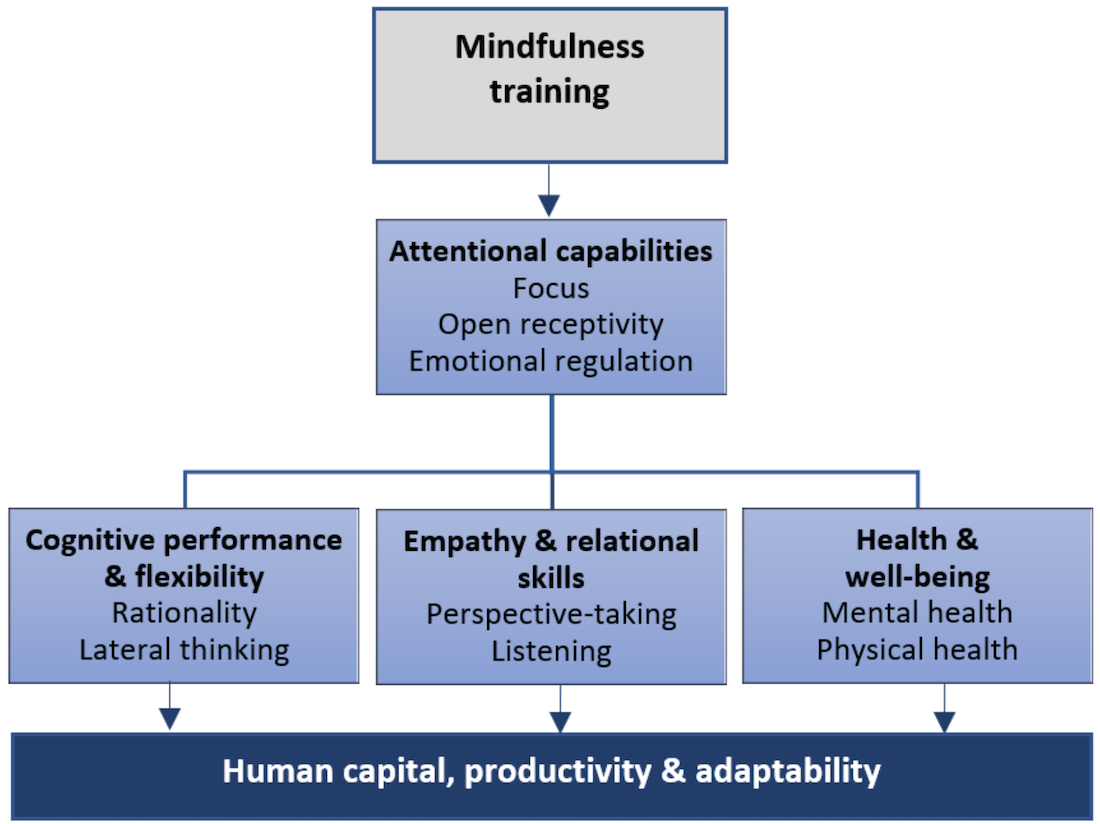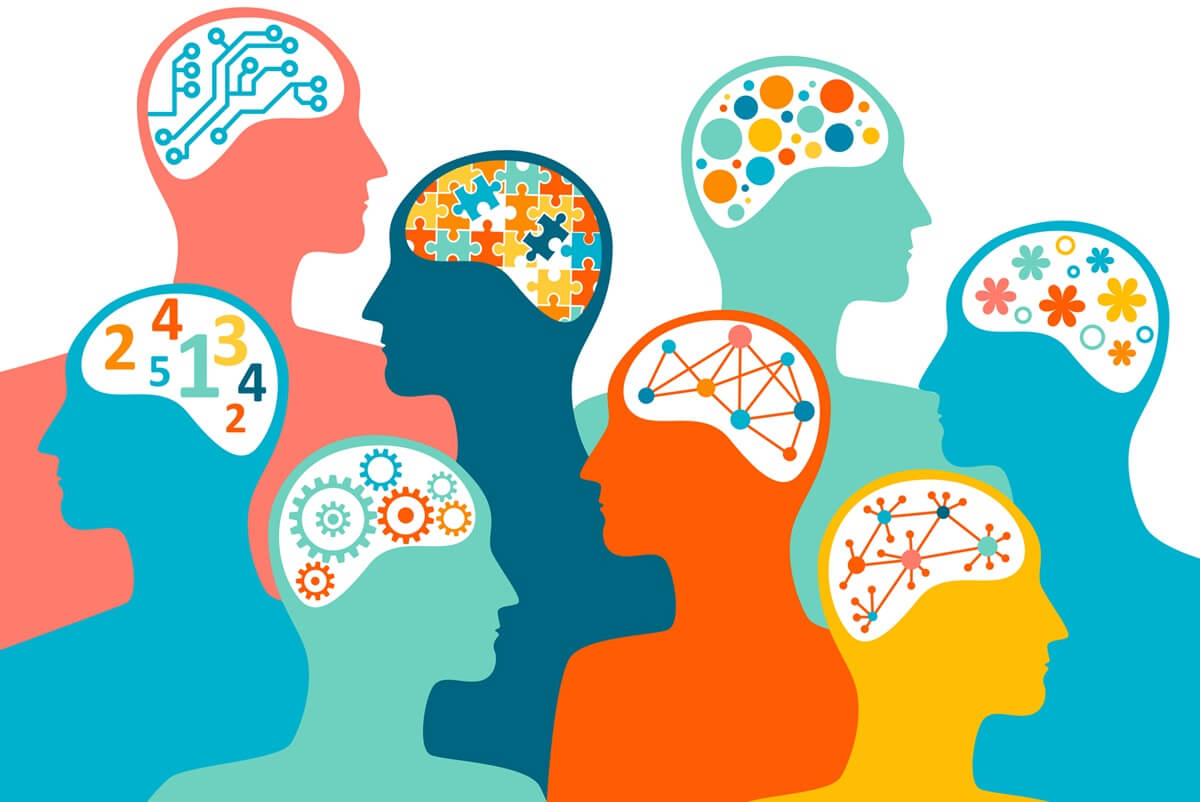The rate of productivity growth in the economy relies on innovation and, in particular, on human capital – the skills and motivation of individuals in the workforce. The world’s total stock of human capital is estimated to be more than twice that of physical capital and the relative importance of human capital is especially the case for knowledge-based economies, like the U.S. and the UK.
Any strategy for a successful economy, therefore, needs to consider the inputs to, and outcomes of, human capital. Below, we outline a framework for thinking about how the cultivation of mindfulness can boost human capital and hence the productive capacity in the economy.
Why Place Mindfulness at the Center of a Human Capital Framework?
To link mindfulness to human capital and productivity, one could draw on the expanding academic literature pointing to positive outcomes of mindfulness training in the context of workplace performance.6 However, such studies inevitably concern specific work contexts, and so to make the case for mindfulness as a capacity that boosts human capital across the economy as a whole, in this series of articles, we focus on evidence around basic human functioning which can be applied to a myriad economic contexts.
Our framework is summarized. The first stage links mindfulness training to practitioners’ attentional capabilities. These then have ‘downstream’ effects in three broad domains: cognitive performance, interpersonal relationships and health.7 Each of these, as well as attention itself, link to components of human capital, and hence productivity, and are discussed in turn below.
Attentional Capabilities
Mindfulness supports the individuals’ ability to focus. The productivity payoffs of this could be very substantial. Distracted minds directly hamper productivity by foregone time spent working: studies suggest our minds are estimated to wander roughly half of our waking hours, and it has been estimated that people typically spend one hour of their workday on social media, rising to 1.8 hours for millennials. Office workers have been estimated to take around 25 minutes to get back to a task they were carrying out before being interrupted. Another study suggests that a ‘barrage of interruptions’ has been estimated to reduce workers’ IQ by 10 points. Beyond these ‘direct’ effects, frequent distractions have feedback loops leading to persistently lower levels of attentional capital and hence productive capacity.
Mindfulness training has been associated with reduced mind wandering and greater attentional control,14 with fewer attentional resources needed to filter out distractions. Accordingly, mindfulness is believed to support attentional efficiency – the economical use of cognitive resources.
Figure 1: Framework relating mindfulness to basic aspects of functioning relevant for human capital and productivity16
The overall productivity gains of higher attentional capital driven by mindfulness training could therefore be very significant in four key areas:18
Cognitive Performance
There is considerable research linking mindfulness to cognitive performance, which is a crucial part of human capital. For instance, mindfulness training has been found to increase individuals’ working memory capacity19 and fluid intelligence (the ability to process and respond to novel information by assessing patterns and relationships) and to reduce the sunk cost bias.20 Consistent with these findings, mindfulness training has been found to increase the density of grey cells in our cerebral cortex, the part of the brain that thinks rationally and solves problems.
Mindfulness is also associated with cognitive flexibility and various aspects of creative thinking. For instance, mindfulness training has been found to boost practitioners’ aptitude for divergent thinking, the ability to generate novel ideas or coming up with higher-order categories to link groups of disparate stimuli.21 More mindful individuals also appear to display better lateral thinking: the ability to solve problems that require overcoming habitual responses derived from prior experience.
Empathy and Relational Skills
Mindfulness is about developing a kind curiosity towards one’s experience which will include, in large measure, our interactions with those around us. Perhaps because of 7 this, several studies have found a positive link between mindfulness training and empathy – the ability to take another’s perspective and to experience the resulting thoughts and feelings.22 Empathy, along with emotional intelligence, is viewed as an increasingly core part of human capital. There is also some evidence linking individuals who have undertaken mindfulness training to respond more compassionately to someone in need and to enjoy more satisfying personal relationships.23
In work contexts, mindfulness-based leadership development programs have become increasingly popular, offering a means for leaders to develop particular capacities in relation to collaboration, perspective-taking, decision-making and resilience.24 The qualitative feedback from leaders who have undertaken such courses is instructive here. For instance, one participant from a 3-day Mindful Leadership program run by Cranfield University commented that following the program, ‘My questions are different and the way I listen to the answers has changed… I now really want to hear what people say’.25 More generally, studies have linked mindfulness to improved relationships at work, supporting collaboration and improving employees’ resilience in the face of challenges.26
Health and Well-being
Mindfulness training has been shown to be effective in improving mental health and well-being in both clinical and non-clinical populations. This has direct implications for human prosperity. In fact, the 2019 report by the All-Party Parliamentary Group on Wellbeing Economics emphasized the treatment of mental illness as its top priority. 27
These findings also matter from a more narrow focus on productivity. Poor mental health is the leading cause of absenteeism in the U.S. and the UK. In this context, there is compelling evidence that mindfulness represents a personal resource that is linked to greater coping ability. Comprehensive meta-analyses have concluded that mindfulness training robustly leads to significant reductions in stress, anxiety and depression.29 A number of studies have specifically investigated the effectiveness of mindfulness for health outcomes in workplace contexts, with promising results.30 Other studies have calculated substantial financial savings, based on reduced absenteeism and higher productivity, as a result of mindfulness-based interventions.31
The research is clear. Human capital is the driver of the global economy. If we can help that capital to be less stressed, more focused, more collaborative, and generally healthier and happier – the benefits to the individual and to the global economy are tremendous and deeply interlinked.
And it can all start with you.
About the Author: This excerpt was edited and reprinted with the permission of our friends at The Mindfulness Initiative. To learn more about their work, please visit www.themindfulnessinitiative.org. View the original work.
View References
6 A recent meta-analysis by Lomas et al (2017), for instance, finds that while further research is needed, mindfulness was generally associated with positive outcomes in relation to most measures of workplace performance, well-being and the cultivation of social capacities, like empathy.
7 See Good et al (2016).
14 This is the ability to appropriately direct attention amid competing demands.
16 This is adapted from the framework set out by Good et al (2016) which draws on theory and evidence across multiple fields linking mindfulness to various aspects of workplace functioning.
18 See Nixon (2017).
21 See Good et al (2016) for a review.
22 In particular, individuals scoring high in trait mindfulness tend to score higher on measures of empathy, and mindfulness training results in significant increases in measured empathy. See for instance Birnie et al (2010).
23 See The Mindfulness Initiative (2016).
24 Ibid. See also, for instance, Hougaard & Carter (2018). 25 Ibid., p.13.
26 A recent meta-analysis by Lomas et al (2017) found that out of five high quality trials, four found significant improvements in measures of empathy (and/or compassion) as a result of higher mindfulness.
27 See https://wellbeingeconomics.co.uk/wp-content/uploads/2019/05/Spending-review-to-ncreasewellbeing-APPG-2019.pdf. 28 See Davies (2014).
29 Compared to waitlist and active controls. See Khoury et al., 2013
30 See Good et al (2016).
31 See Aikens et al (2014). Based on average wages, reductions in burnout and subsequent potential increase in workforce productivity, the authors estimated savings to be up to $22,000 per employee.










